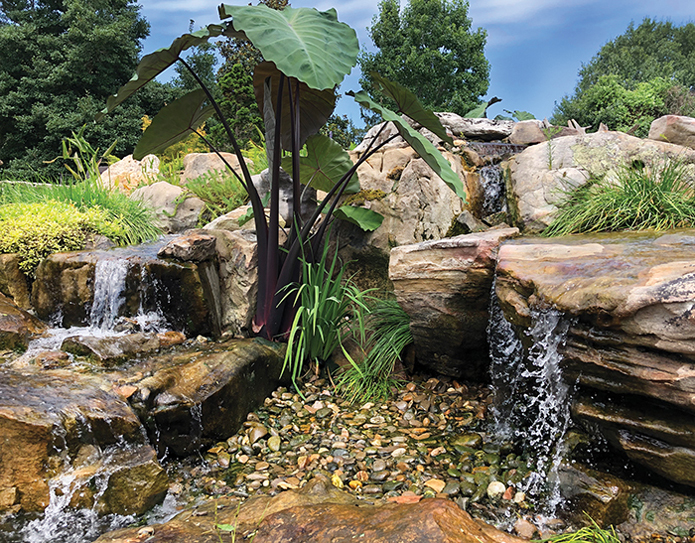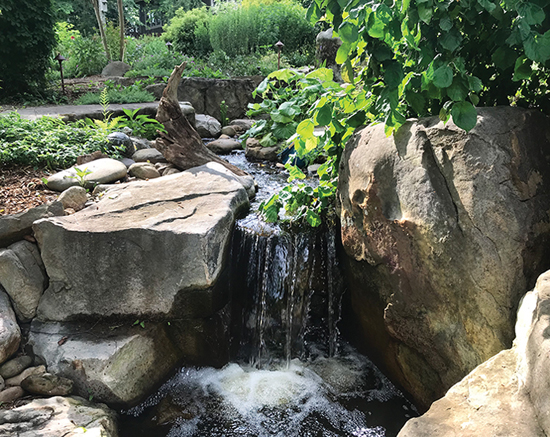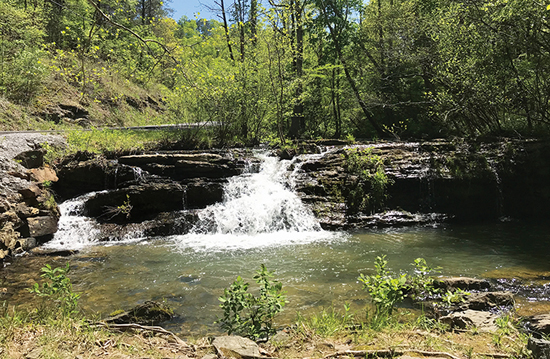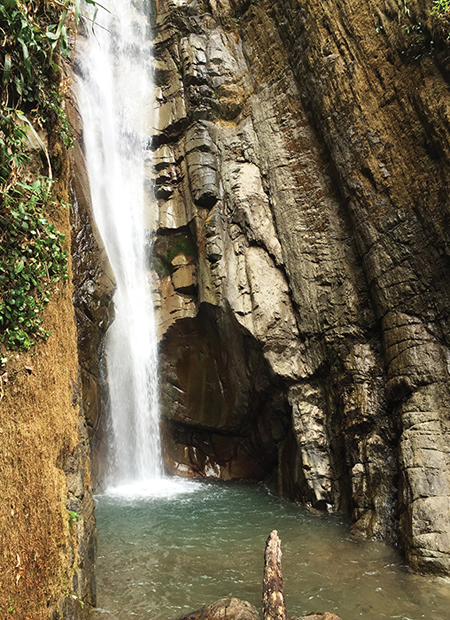
Sound is all around us, from birds chirping on a cool, crisp morning to waves crashing on the beach.
Most sounds are filtered or otherwise dismissed, but some bring us back to a place of comfort as soon as we hear them. For example, when I hear the soft crackling of an open fire, I think of the wood stove burning on a cold night at my father’s house. Sometimes we rarely think of these sounds until we are reminiscing about times that are long past, and then we find ourselves longing for them.
Key of the Fountain
Water has always been a passion of mine. About seven years into my career, I noticed something in particular that I loved about building ecosystems — the sounds of water. From the deep bass tone that comes from water falling into a deep pool to the high-pitch splatter from water falling directly on other stones, each and every waterfall has a unique sound.I first noticed this when I was playing guitar next to the splash pad at my father’s house, listening to the birds chirping in the background along with the cicadas. As I tried to find a rhythm on my guitar to match the cicadas and birds, I realized that there was only one thing I could hear that had a set rhythm — the fountain splashing off the pavers. After a few minutes of picking around on my guitar, I discovered its tone, and then wrote a song in the “key of the fountain.” No matter what I played within that scale, the fountain seemed to complement every note.

Build in Harmony
Today, when I’m building waterfalls, I can almost hear these sounds from my past splashing down as I work. Whether it is a 50-foot-long boulder stream or a 5-foot babbling brook, there are so many different possibilities. I’ve noticed that I always end up “tuning” each waterfall a little differently from the previous one.
One of my favorite sounds is when two waterfalls with different tones complement each other. Just like in the world of music, you can play two completely different notes that may sound odd by themselves, but when you play them at the same time, they come together for a more sophisticated sound. Rarely is it perfect unison right off the bat, but after a bit of tweaking where the water lands, you can start to create beautiful harmonies. Personally, my ears prefer high and low-pitched notes simultaneously over having multiple high or low tones. In fact, every song I write and every waterfall I build has high notes overlapping low notes to achieve the sound I’m looking for. Diversifying the sound of a waterfall can be just as important as perfecting the way it looks.

Shrapnel Falls
Many of my go-to styles and sounds have been inspired by other artists in the industry whom I have gotten the privilege of working with over the years.
Just over a year ago, I was in Bolton Landing, New York, working on a large pond and waterfall build. As we constructed the stream, I was working side by side with Sean Frost of NatureScapes in New Hampshire. He had so many different styles that appealed to me not only visually, but phonetically as well. I noticed him smashing smaller stones into “shrapnel,” and it sparked my curiosity.
Why would he take a bunch of intact stones and pummel them into a pile of sharp pieces? I asked myself. I watched him manipulate the sharp pieces in a way that would create white water as the water crashed into and over the pieces. We dubbed the style Shrapnel Falls right there on the spot. The sharp pieces had no correlation really, but they were placed between larger framing rocks taking the place of the waterfall stone.
Tuning Tips
Generally, I like to use three stones to construct the actual waterfall — two higher stones on the sides, with a lower-lying stone in the middle for the water to flow over. This can create many different styles of waterfalls, depending on the stone you choose. You can split up the same volume of water over a wider stone to slow it down, which actually can reduce sound output. Take the same amount of water and put it through a pinch falls, or two rocks almost touching, and the water will shoot out between them in a much more dramatic fashion, thus increasing the sound output.

deep in the mountains of Colombia.
Most of the time when I’m designing a waterfall, I think of the sound it will make based on the impact it makes when hitting the stones or pool of water. In the case of the Shrapnel Falls style, water crashes into each sharp piece before it falls, causing white water and generating sound before the water even hits the bottom of the waterfall.
Another way I like to manipulate the sound of a waterfall is by angling the framing stones toward the viewing area or placing stones outside the waterfall, directing the sound toward the viewing area. Sound bounces off stone, so you can direct it to where you want it. Even if the waterfall is around the corner of the house, a large, correctly placed stone nearby can project sound around the corner. This way, you can hear the gentle sound of moving water without the waterfall even in sight.
Earthly Encouragement
As many techniques as I’ve learned through other contractors, I can’t forget my biggest inspiration of all — Mother Nature. I love to hike and experience the different styles that occur naturally. One of my local favorites is a five-mile hike to Abrams Falls in Blount County, Tennessee. Just being in the presence of this waterfall alone is worth the trip, not to mention the beautiful pines and hemlocks that line the path along the way.
The waterfall itself is only about 20 feet high, but with the massive amount of water flowing over it, you can hear it from a half mile away on a quiet day. Parts of the waterfall hit flat stones, creating a very high-pitched splatter, but most of the water falls straight into a deep pool at the base of the falls, giving off a very deep, bass-like tone that projects for incredible distances.
Looking at this waterfall, it appears as though it is composed of a singular stone that time and the elements have carved a path through. A stone of this magnitude would be next to impossible to recreate in a backyard scenario, but it certainly gets the creativity flowing nevertheless.

Another inspiring journey was to the Primavera Urbana in Colombia, South America. We teamed up with some of the best water-feature builders from across the world to build an amazing pond and waterfall that became the show-stealer for a 10-story, open-air mall located in Villavicencio.
On our first off day, we sat and discussed two options: hike to a remote waterfall miles into the mountains, or float down the river on inner tubes with some cold cervesa. Naturally, beer and relaxing sounded phenomenal after a long week of work, but the inner artists in us prevailed and chose the hike instead.
After many miles of making our way through the forest, from heavily-walked trails to trails used for herding cattle, we found ourselves at what appeared to be the very top of the mountain. Despite the high humidity and 95-degree weather, the water spewing from the top of this mountain felt as cold as ice. A giant rock face carved smooth by the many years of erosion stood tall at the end of our journey. You could hear the tones of this waterfall ringing from almost a mile away due to the height of the falls and massive amount of water volume coming down. It was one of the most challenging hikes I’ve ever been on, but when I approached the waterfall and the cold crisp mist from the waterfall encompassed me, it felt like I was instantly rejuvenated.
The waterfall had a beautiful mixture of sounds, from incredibly deep-bass tones as the water fell into the pool beneath it, to the splatter off the boulders as it continued down the mountain, splitting off into smaller and smaller streams.
This was one of the most beautiful places I have ever seen, and the memories and ambience at the top of that mountain will stay with me forever, serving as endless inspiration for “tuning” future water features.


